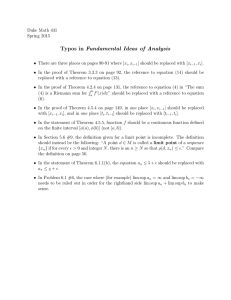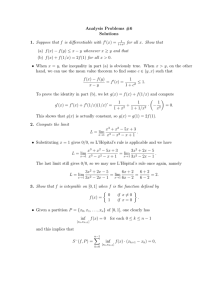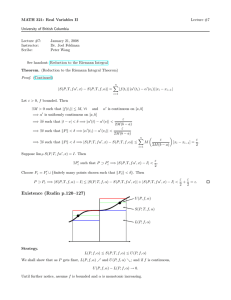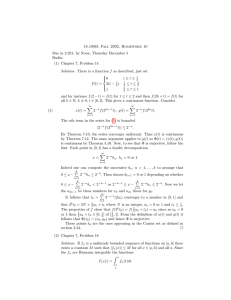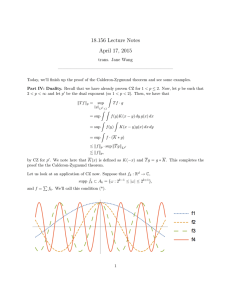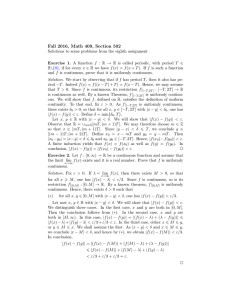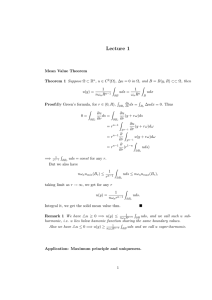Class notes Nov
advertisement
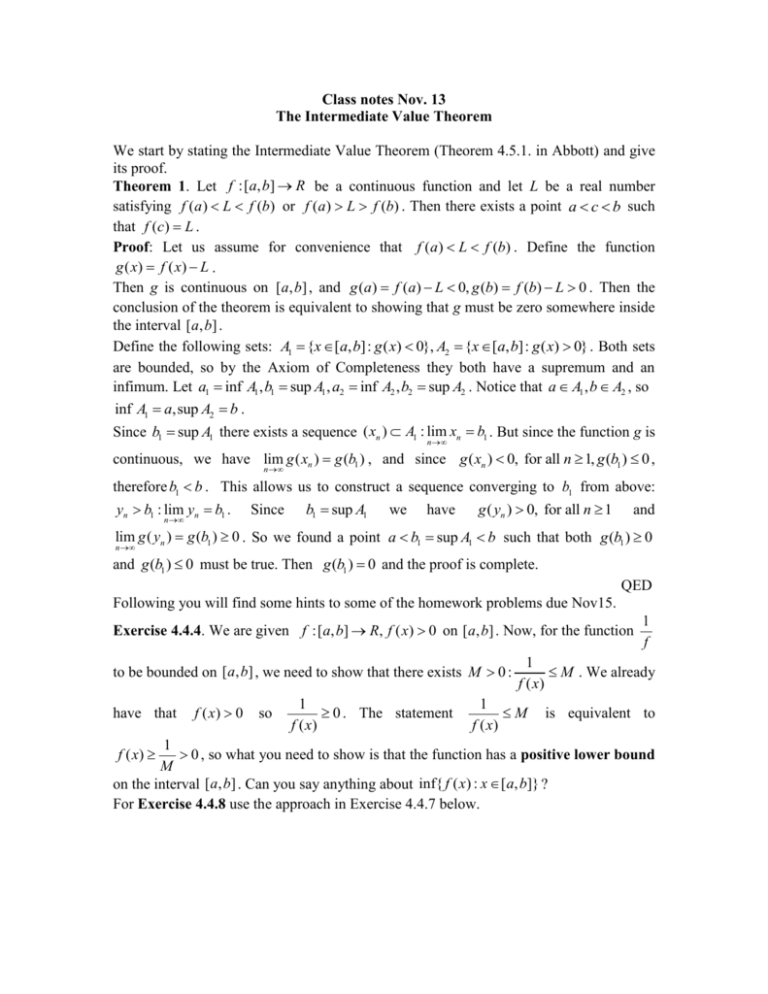
Class notes Nov. 13
The Intermediate Value Theorem
We start by stating the Intermediate Value Theorem (Theorem 4.5.1. in Abbott) and give
its proof.
Theorem 1. Let f :[a, b] R be a continuous function and let L be a real number
satisfying f (a) L f (b) or f (a) L f (b) . Then there exists a point a c b such
that f (c) L .
Proof: Let us assume for convenience that f (a) L f (b) . Define the function
g ( x) f ( x) L .
Then g is continuous on [a, b] , and g (a) f (a) L 0, g (b) f (b) L 0 . Then the
conclusion of the theorem is equivalent to showing that g must be zero somewhere inside
the interval [a, b] .
Define the following sets: A1 {x [a, b]: g ( x) 0}, A2 {x [a, b]: g ( x) 0} . Both sets
are bounded, so by the Axiom of Completeness they both have a supremum and an
infimum. Let a1 inf A1 , b1 sup A1 , a2 inf A2 , b2 sup A2 . Notice that a A1 , b A2 , so
inf A1 a,sup A2 b .
Since b1 sup A1 there exists a sequence ( xn ) A1 : lim xn b1 . But since the function g is
n
continuous, we have lim g ( xn ) g (b1 ) , and since g ( xn ) 0, for all n 1, g (b1 ) 0 ,
n
therefore b1 b . This allows us to construct a sequence converging to b1 from above:
yn b1 : lim yn b1 . Since b1 sup A1 we have
g ( yn ) 0, for all n 1 and
n
lim g ( yn ) g (b1 ) 0 . So we found a point a b1 sup A1 b such that both g (b1 ) 0
n
and g (b1 ) 0 must be true. Then g (b1 ) 0 and the proof is complete.
QED
Following you will find some hints to some of the homework problems due Nov15.
Exercise 4.4.4. We are given f :[a, b] R, f ( x) 0 on [a, b] . Now, for the function
to be bounded on [a, b] , we need to show that there exists M 0 :
have that
f ( x) 0
so
1
0 . The statement
f ( x)
1
f
1
M . We already
f ( x)
1
M
f ( x)
is equivalent to
1
0 , so what you need to show is that the function has a positive lower bound
M
on the interval [a, b] . Can you say anything about inf{ f ( x) : x [a, b]} ?
For Exercise 4.4.8 use the approach in Exercise 4.4.7 below.
f ( x)
Exercise 4.4.7. We have g uniformly continuous on (a, b] and [b,c),a<b<c .
We write the uniform continuity for the two intervals. Let 0 . We know that there
exists 1 0 such that for any x, y (a, b] :| x y | 1 ,| g ( x) g ( y ) | (1). You will see
2
later why we chose
in the above.
2
Also, since g is uniformly continuous on [b,c) , there exists 2 0 such that for any
x, y [b, c) :| x y | 2 ,| g ( x) g ( y ) | (2).
2
Let min{1 , 2 } . From (1) and (2) it follows that if x, y (a, c) :| x y | and either
x, y (a, b] or x, y [b, c) then | g ( x) g ( y ) | . However, we should ask ourselves
2
what happens if x b y :| x y | ? Notice that in this case | x b | and | y b |
and | g ( x) g (b) | ,| g (b) g ( y ) | . Then we write
2
2
| g ( x) g ( y ) || g ( x) g (b) | | g (b) g ( y ) |
2 2
and we are done.
Remark. If in the above we knew that the function is uniformly continuous on two
overlapping intervals, such as (a, b],[d , c), a d b c then there would be no need of
discussing the case x b y :| x y | separately. Think about this when doing
exercise 4.4.8.
Exercise 4.4.11. (Topological Characterization of Continuity) Let g : R R . Define the
preimage of a set A: g 1 ( A) {x R : g ( x) A} . Show that g is continuous if and only if
for any open set O R, g 1 (O) is open.
Proof: We need to prove two implications here.
Let’s assume first that g is continuous, and let O R be open. We will prove that
g 1 (O) is open by proving that all points in g 1 (O) are interior points. Let a g 1 (O) .
Then g (a) O and since O is open, there exists a neighborhood of g ( a ) contained in O,
that is: there exists 0 such that ( g (a) , g (a) ) O . Since the function is
continuous at a there exists 0 such that for any x :| x a | ,| g ( x) g (a) | , or
equivalently g ( x) ( g (a) , g (a) ) O . But if g ( x) O it follows that x g 1 (O)
for all x :| x a | , so (a , a ) g 1 (O) , proving that g 1 (O) is open.
Conversely, let us assume g 1 (O) is open for any open set O. Let a R and let 0 .
Define the open set O ( g (a) , g (a) ) . According to our assumption g 1 (O) must
be open as well, and we also know that a g 1 (O) . Since g 1 (O) is open we can find a
-neighborhood of a contained in g 1 (O) , that is there exists 0 such that
(a , a ) g 1 (O) . This last statement implies that g ( x) O for all x :| x a | , or
equivalently | g ( x) g (a) | for all x :| x a | , proving that g is continuous at a.
QED
